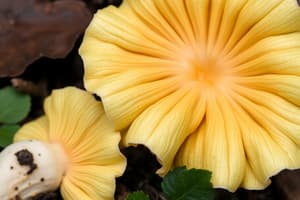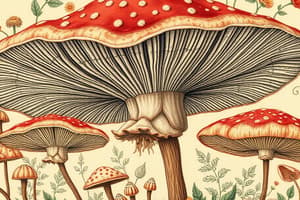Podcast
Questions and Answers
What do some biologists mean when they say that a mushroom is much like an iceberg?
What do some biologists mean when they say that a mushroom is much like an iceberg?
Typically, we see only the fruiting body of a mushroom. Like an iceberg, that visible part is only a small fraction of the total mushroom, because the mycelium is the largest component.
What is the difference between septate and nonseptate hyphae?
What is the difference between septate and nonseptate hyphae?
Septate hyphae have cell walls to septate the cells while non-septate hyphae do not.
What is the function of rhizoid hyphae, stolons, sporophores, and haustoria?
What is the function of rhizoid hyphae, stolons, sporophores, and haustoria?
Rhizoid hyphae support and digest food for the fungus. Stolons asexually reproduce. Sporophores release spores. Haustoria invade host cells to absorb food.
Of the hyphae listed, which are aerial?
Of the hyphae listed, which are aerial?
What is the difference between a sporangiophore and a conidiophore?
What is the difference between a sporangiophore and a conidiophore?
Give the main characteristic associated with each of the phyla of kingdom Fungi.
Give the main characteristic associated with each of the phyla of kingdom Fungi.
Describe the stages associated with the life cycle of a mushroom, starting with the formation of the mycelium.
Describe the stages associated with the life cycle of a mushroom, starting with the formation of the mycelium.
What is the main difference between shelf fungi, puffballs, and mushrooms?
What is the main difference between shelf fungi, puffballs, and mushrooms?
What is an alternate host?
What is an alternate host?
What type of fungus is best known for fermentation, and to which phylum does it belong?
What type of fungus is best known for fermentation, and to which phylum does it belong?
How is budding different from asexual reproduction in bacteria?
How is budding different from asexual reproduction in bacteria?
Name at least two pathogenic fungi and the maladies they cause.
Name at least two pathogenic fungi and the maladies they cause.
Describe the three ways a bread mold can reproduce and specify whether the reproduction is sexual or asexual.
Describe the three ways a bread mold can reproduce and specify whether the reproduction is sexual or asexual.
Flashcards are hidden until you start studying
Study Notes
Mushroom Structure and Comparison
- Mushrooms consist mainly of mycelium, with the fruiting body representing only about 10% visible above ground.
- Mycelium is the largest part of the mushroom, similar to the underwater portion of an iceberg.
Hyphal Characteristics
- Septate hyphae contain cell walls to separate individual cells.
- Nonseptate hyphae do not have these cell walls.
Specialized Hyphae Functions
- Rhizoid hyphae provide support and digest nutrients.
- Stolons are responsible for asexual reproduction.
- Sporophores release spores for reproductive processes.
- Haustoria invade host cells to absorb nutrients directly from the cytoplasm.
Aerial Hyphae
- Stolons and sporophores are classified as aerial hyphae.
Spores and Conidiophores
- Sporangiophores produce spores within an enclosure.
- Conidiophores release spores freely without an enclosing structure.
Fungal Phyla Characteristics
- Basidiomycota: sexual spores produced on club-like basidia.
- Ascomycota: sexual spores formed in sac-like asci.
- Zygomycota: sexual spores formed via the fusion of hyphae.
- Chytridiomycota: produce spores with flagella.
- Deuteromycota: fungi lacking identified sexual reproduction methods.
- Myxomycota: fungi resembling protozoa during life cycle.
Mushroom Life Cycle Stages
- Starts as mycelium from spores of another mushroom.
- Compatible mycelia may intertwine, leading to sexual reproduction.
- Newly formed hyphae create a complex web and enclose in a membrane, reaching the button stage.
- Rapid water absorption causes stipe and cap to break through the membrane.
- The fruiting body releases spores, which can grow into new mycelia in favorable environments.
Differentiation of Fungi Types
- Mushrooms produce spores on basidia located in the gills of the cap.
- Puffballs create spores within a membrane-enclosed structure.
- Shelf fungi produce spores on basidia found in the pores of the fruiting body.
Alternate Hosts
- An alternate host is a secondary host used by parasitic fungi during part of their life cycle; they do not primarily reside on this host.
- Rust fungi are an example of fungi utilizing an alternate host.
Yeast and Fermentation
- Yeast, belonging to the phylum Ascomycota, is well-known for its fermentation abilities.
Budding vs. Bacterial Reproduction
- In budding, offspring remain attached to the parent until maturation, differing from bacterial reproduction where offspring develop independently.
Pathogenic Fungi
- Rusts and smuts are examples of pathogenic fungi, primarily causing crop damage.
Bread Mold Reproduction Methods
- Asexual reproduction occurs via stolons elongating to form new mycelium or the formation of sporophores from aerial hyphae.
- Sexual reproduction takes place through the formation of a zygospore when two mycelia join.
Studying That Suits You
Use AI to generate personalized quizzes and flashcards to suit your learning preferences.




